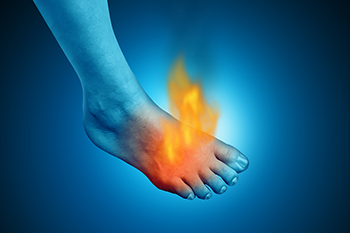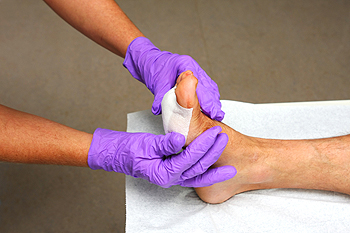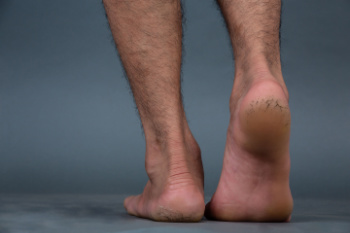Items filtered by date: August 2025
Reasons Your Feet May Feel Like They Are Burning

Burning feet can be a sign of peripheral neuropathy, which involves damage to the nerves that extend into the feet. One cause is diabetic neuropathy, where high blood sugar harms nerve fibers over time, leading to burning, tingling, or numbness. Alcohol abuse can also damage nerves through oxidative stress. This condition occurs when the body accumulates too many unstable molecules that injure healthy cells, including nerve tissue. Another cause of burning feet is amyloid neuropathy. This develops when abnormal proteins, called amyloid, collect in nerve tissues and interfere with normal nerve function. Symptoms include burning sensations, loss of balance, or numbness in the feet. The discomfort from these conditions often intensifies at night, when cooler temperatures and less distraction may heighten pain awareness. A podiatrist can evaluate these symptoms and provide appropriate treatment. If you are experiencing the sensation of burning feet, it is suggested that you schedule an appointment with a podiatrist for an exam and diagnosis.
Neuropathy
Neuropathy can be a potentially serious condition, especially if it is left undiagnosed. If you have any concerns that you may be experiencing nerve loss in your feet, consult with Gabe Rodriguez, DPM from Center for Lower Extremity Wound Healing. Our doctor will assess your condition and provide you with quality foot and ankle treatment for neuropathy.
What Is Neuropathy?
Neuropathy is a condition that leads to damage to the nerves in the body. Peripheral neuropathy, or neuropathy that affects your peripheral nervous system, usually occurs in the feet. Neuropathy can be triggered by a number of different causes. Such causes include diabetes, infections, cancers, disorders, and toxic substances.
Symptoms of Neuropathy Include:
- Numbness
- Sensation loss
- Prickling and tingling sensations
- Throbbing, freezing, burning pains
- Muscle weakness
Those with diabetes are at serious risk due to being unable to feel an ulcer on their feet. Diabetics usually also suffer from poor blood circulation. This can lead to the wound not healing, infections occurring, and the limb may have to be amputated.
Treatment
To treat neuropathy in the foot, podiatrists will first diagnose the cause of the neuropathy. Figuring out the underlying cause of the neuropathy will allow the podiatrist to prescribe the best treatment, whether it be caused by diabetes, toxic substance exposure, infection, etc. If the nerve has not died, then it’s possible that sensation may be able to return to the foot.
Pain medication may be issued for pain. Electrical nerve stimulation can be used to stimulate nerves. If the neuropathy is caused from pressure on the nerves, then surgery may be necessary.
If you have any questions, please feel free to contact our office located in Sioux Falls, SD . We offer the newest diagnostic and treatment technologies for all your foot care needs.
Keep Your Feet Healthy So You Can Stay Active
How Negative Pressure Helps Heal Wounds

Negative pressure wound therapy is a treatment option that can help promote healing for wounds that do not respond well to standard care, particularly those on the feet and ankles. This therapy involves sealing the wound with a special dressing made from sponge material or gauze, connected to a pump that removes fluids from the wound. This reduction in pressure encourages blood flow to the area and helps keep the wound moist, which can improve healing. It is commonly used for chronic wounds that have failed to heal after several weeks. Negative pressure wound therapy is particularly effective for large or infected wounds that cannot be closed directly. While studies suggest that this treatment may improve healing times, results can vary depending on the type and severity of the wound. If you have foot wounds that will not heal properly, it is suggested that you schedule an appointment with a podiatrist to see if negative pressure therapy is right for you.
Wound care is an important part in dealing with diabetes. If you have diabetes and a foot wound or would like more information about wound care for diabetics, consult with Gabe Rodriguez, DPM from Center for Lower Extremity Wound Healing. Our doctor will assess your condition and provide you with quality foot and ankle treatment.
What Is Wound Care?
Wound care is the practice of taking proper care of a wound. This can range from the smallest to the largest of wounds. While everyone can benefit from proper wound care, it is much more important for diabetics. Diabetics often suffer from poor blood circulation which causes wounds to heal much slower than they would in a non-diabetic.
What Is the Importance of Wound Care?
While it may not seem apparent with small ulcers on the foot, for diabetics, any size ulcer can become infected. Diabetics often also suffer from neuropathy, or nerve loss. This means they might not even feel when they have an ulcer on their foot. If the wound becomes severely infected, amputation may be necessary. Therefore, it is of the upmost importance to properly care for any and all foot wounds.
How to Care for Wounds
The best way to care for foot wounds is to prevent them. For diabetics, this means daily inspections of the feet for any signs of abnormalities or ulcers. It is also recommended to see a podiatrist several times a year for a foot inspection. If you do have an ulcer, run the wound under water to clear dirt from the wound; then apply antibiotic ointment to the wound and cover with a bandage. Bandages should be changed daily and keeping pressure off the wound is smart. It is advised to see a podiatrist, who can keep an eye on it.
If you have any questions please contact our office located in Sioux Falls, SD . We offer the newest diagnostic and treatment technologies for all your foot and ankle needs.
Cracked Heels Can Disrupt Daily Movement

Dry, cracked heels may seem like a small issue, but they can make walking uncomfortable and even painful. As the skin on the heel thickens and splits, pressure from standing or walking can deepen the cracks. In some cases, the skin may bleed or become infected. This is especially concerning for older adults or people with circulation problems. Cracked heels are often caused by dryness, long periods of standing, wearing unsupportive footwear, or being barefoot on hard surfaces. Once the skin breaks down, each step can cause discomfort, making it harder to stay active. Moisturizing the feet regularly, using gentle exfoliation, and wearing cushioned shoes can help. If deep cracks on your heels are making it hard to walk or are showing signs of infection, it is suggested that you visit a podiatrist for appropriate care and relief.
Cracked heels are unsightly and can cause further damage to your shoes and feet. If you have any concerns, contact Gabe Rodriguez, DPM from Center for Lower Extremity Wound Healing. Our doctor can provide the care you need to keep you pain-free and on your feet.
Cracked Heels
Cracked heels appear unappealing and can make it harder for you walk around in sandals. Aside from looking unpleasant, cracked heels can also tear stockings, socks, and wear out your shoes. There are several methods to help restore a cracked heel and prevent further damage.
How Do You Get Them?
Dry skin is the number one culprit in creating cracked heels. Many athletes, walkers, joggers, and even swimmers suffer from cracked heels. Age and skin oil production play a role to getting cracked heels as well.
Promote Healing
Over the counter medicines can help, especially for those that need instant relief or who suffer from chronic dry feet.
Wear Socks – Wearing socks with medicated creams helps lock in moisture.
Moisturizers – Applying both day and night will help alleviate dryness which causes cracking.
Pumice Stones – These exfoliate and remove dead skin, which allows for smoother moisturizer application and better absorption into the skin.
Change in Diet
Eating healthy with a well-balanced diet will give the skin a fresh and radiant look. Your body responds to the kinds of food you ingest. Omega-3 fatty acids and zinc supplements can also revitalize skin tissue.
Most importantly, seek professional help if unsure how to proceed in treating cracked heels. A podiatrist will help you with any questions or information needed.
If you have any questions, please feel free to contact our office located in Sioux Falls, SD . We offer the newest diagnostic and treatment technologies for all your foot care needs.

